SAS Bundle
How Does SAS Dominate the Data Analytics Market?
Founded in 1976, SAS has evolved from a statistical analysis software provider to a global leader in data analytics and AI. With the rise of cloud-native platforms, SAS has adapted, achieving significant growth, particularly with SAS Viya. This transformation underscores the importance of understanding SAS's strategic approach to maintain its market leadership.
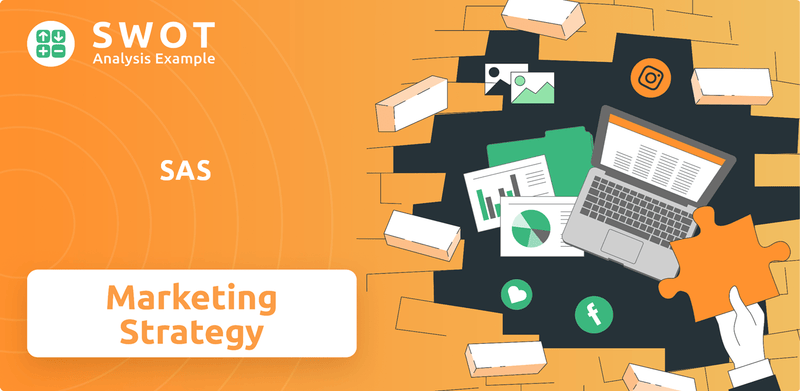
To understand SAS's enduring success, we must examine its SAS SWOT Analysis and how it has strategically positioned itself. This analysis will explore the core of the SAS sales strategy and SAS marketing strategy, revealing how the company has consistently generated sales and fostered customer acquisition. We'll also delve into the SAS company strategy, including its business model, marketing campaign examples, and digital marketing strategy to provide actionable insights for businesses.
How Does SAS Reach Its Customers?
The sales channels of the company are a crucial part of its overall strategy, utilizing a mix of direct and indirect methods to reach a diverse global customer base. These channels include direct sales teams, an extensive network of partners, and cloud-based deployments. This multi-faceted approach allows the company to cater to different customer needs and market segments effectively.
Historically, the company has relied heavily on its direct sales force, building strong relationships with large enterprises, particularly in sectors like banking, insurance, and government. This direct engagement has enabled the company to provide tailored solutions and extensive consulting services. This customer-centric approach has been a key differentiator.
The evolution of these channels reflects the company's strategic shift towards cloud adoption and broader market segmentation. The cloud-native data and AI platform, has been a key driver, with cloud sales growing significantly in recent years. The company is actively expanding its cloud deployment options, with plans to add an as-a-service option in 2026.
The company's direct sales teams focus on building and maintaining relationships with large enterprise clients. This approach allows for the provision of tailored solutions and extensive consulting services, catering to the specific needs of each client. This is a key aspect of the company's customer-centric approach.
The company leverages a robust network of over 1,300 partners across 94 countries. These partnerships are strategic, supporting global sales and embedding the company's solutions into other ecosystems. Partners play a crucial role in the company's growth strategy, influencing a significant percentage of total new software and hosting sales.
The company is actively expanding its cloud deployment options, with plans to add an as-a-service option in 2026. Cloud-native data and AI platform has been a key driver, with cloud sales growing significantly. The company is progressing towards being fully cloud service provider (CSP) agnostic.
Partnerships are a crucial part of the company's growth strategy, influencing 65% of total new software and hosting sales in 2024. These partnerships are strategic, supporting global sales in regions where a large in-country presence isn't economical. Partners provide solution delivery, development, and co-creation.
The company's SAS sales strategy is evolving to embrace cloud adoption and expand its market reach. The focus on partnerships is critical for global expansion and providing comprehensive solutions. The company's SAS marketing strategy is also adapting to support these shifts, focusing on cloud-based solutions and partner ecosystems.
- Cloud adoption is a key growth driver, with SAS Managed Cloud Services sales growing by 16% in 2024.
- Partnerships are crucial, influencing 65% of total new software and hosting sales in 2024.
- The company is expanding its cloud deployment options, with an as-a-service option planned for 2026.
- The company's SAS business model is adapting to these changes, ensuring it remains competitive.
SAS SWOT Analysis
- Complete SWOT Breakdown
- Fully Customizable
- Editable in Excel & Word
- Professional Formatting
- Investor-Ready Format
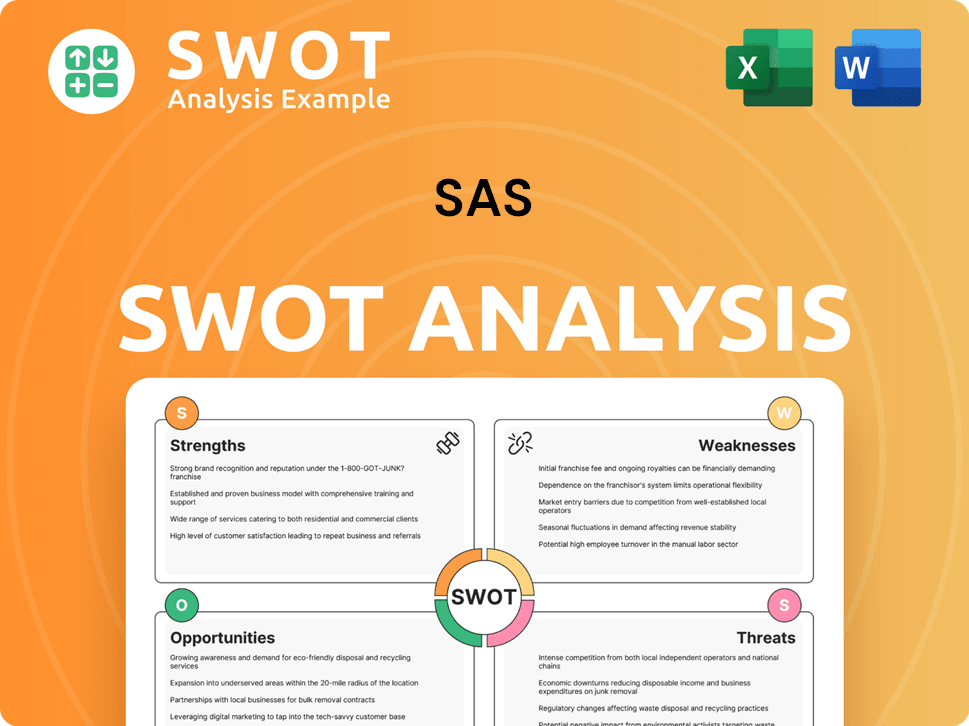
What Marketing Tactics Does SAS Use?
The company employs a multifaceted marketing strategy, skillfully blending digital innovation with traditional methods to boost awareness, generate leads, and drive sales within the competitive analytics and AI market. This approach is designed to establish the company as a trusted resource, leveraging data-driven marketing, customer segmentation, and personalization to deliver tailored content based on user behavior and preferences. The company's marketing tactics also include a strong emphasis on digital and social media engagement, utilizing targeted social media advertising and data analytics to create personalized ads that address specific customer pain points.
A core element of the company's strategy is content marketing, where the company creates valuable and informative content, including industry insights, case studies, and thought leadership pieces. The company also leverages traditional media and events, with its annual 'SAS Insight' conference serving as a key platform to showcase its strategic focus on AI, innovation, and ecosystem expansion. The company actively participates in industry events and utilizes its public relations to highlight customer success stories and analyst validations.
In 2025, the company anticipates marketers will move from simpler generative AI applications to more advanced AI capabilities for competitive advantage and revenue growth, embracing synthetic data and digital twins. There's also a renewed focus on traditional AI technologies like natural language processing, text analytics, sentiment analytics, and predictive analytics for front-end customer experience applications. Furthermore, campaign management is predicted to regain prominence in 2025 as organizations transition to cloud data strategies, recognizing the value of segmentation and audience creation.
The company uses content marketing to establish itself as a trusted resource. This includes creating valuable content such as industry insights, case studies, and thought leadership pieces.
The company emphasizes digital and social media engagement. Targeted social media advertising and data analytics are used to create personalized ads that address specific customer pain points.
The company focuses on data-driven marketing, customer segmentation, and personalization. Advanced AI tools and increased data availability enable highly personalized marketing campaigns.
The company's Customer Intelligence 360 platform unifies diverse customer data. This creates comprehensive profiles for precise segmentation and targeted multi-channel campaigns.
The company leverages traditional media and events, such as the annual 'SAS Insight' conference. This serves as a platform to showcase its strategic focus on AI and innovation.
The marketing mix is evolving with a strong push towards AI-driven strategies. In 2025, the company anticipates marketers will embrace advanced AI capabilities.
The company's Growth Strategy of SAS includes a strong emphasis on marketing tactics. The company's approach includes data-driven marketing and personalization, which are crucial for the company's success. The company's customer acquisition strategy also involves leveraging both digital and traditional marketing channels. The company's sales and marketing alignment is crucial for lead generation and conversion. The company's digital marketing strategy includes the use of social media and content marketing. The company's marketing campaign examples often highlight its innovative software solutions and its commitment to customer relationship management.
The company employs a variety of marketing tactics to build awareness and drive sales. These tactics include content marketing, digital and social media engagement, and the use of traditional media and events.
- Content Marketing: The company creates valuable content such as industry insights and case studies.
- Digital and Social Media: The company uses targeted advertising and data analytics.
- Customer Intelligence 360: This platform unifies customer data for segmentation.
- Events and Traditional Media: The company hosts events and utilizes public relations.
SAS PESTLE Analysis
- Covers All 6 PESTLE Categories
- No Research Needed – Save Hours of Work
- Built by Experts, Trusted by Consultants
- Instant Download, Ready to Use
- 100% Editable, Fully Customizable
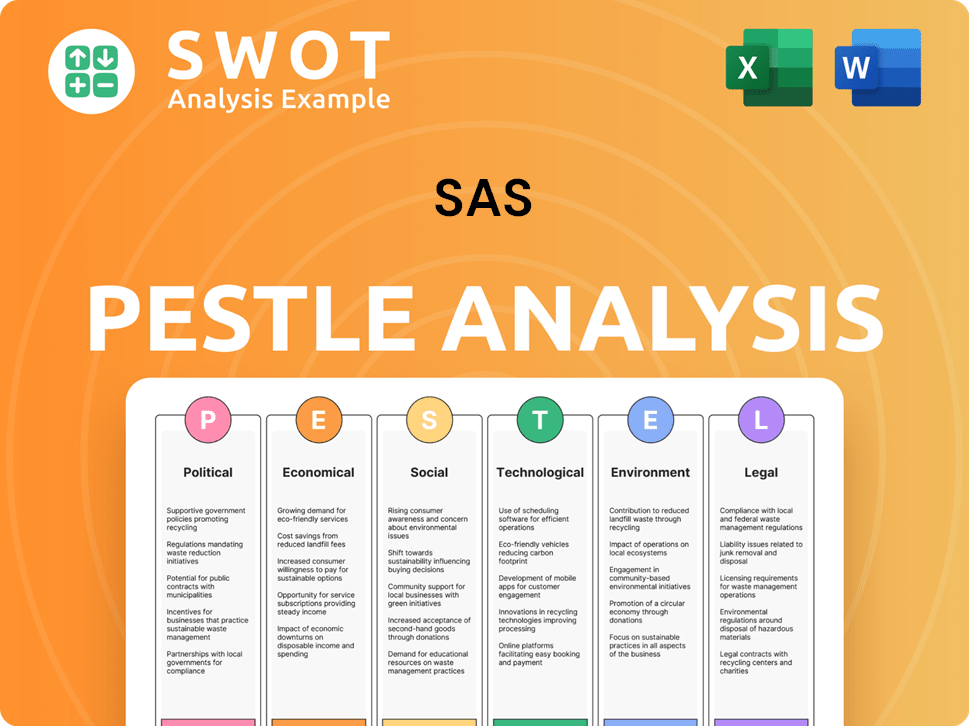
How Is SAS Positioned in the Market?
The core of the brand positioning for SAS revolves around being the most trustworthy data and AI partner, powering decisions globally. This emphasizes reliability, expertise, and actionable insights derived from their analytics software. The focus is on delivering solutions that drive performance improvements for organizations through data insights, streamlined processes, and cost reductions.
SAS differentiates itself through continuous innovation, deep industry expertise, and a proven track record. Their visual identity and tone of voice consistently reflect a data-driven intelligence and professional, authoritative presence. They target financially-literate decision-makers, business strategists, and financial professionals, demonstrating how their solutions help improve performance.
In 2024, SAS invested significantly in its software portfolio and enhanced its data and AI platform, SAS Viya, adding new features and innovative packaged AI models. This commitment underscores their dedication to providing cutting-edge solutions and maintaining a strong market position. The Growth Strategy of SAS highlights their commitment to innovation and customer success.
SAS employs a direct sales model, focusing on enterprise clients. Their sales process emphasizes building relationships and understanding client needs to offer tailored solutions. The sales team is structured to support complex deals and provide ongoing customer support, which is a key part of their SAS sales strategy.
The SAS marketing strategy centers on thought leadership, content marketing, and digital channels. They use webinars, white papers, and case studies to educate and engage their target audience. This approach helps generate leads and establish SAS as an authority in data analytics and AI.
SAS customer acquisition relies on a combination of inbound and outbound marketing. They focus on attracting leads through valuable content and nurturing them through the sales funnel. The company also actively participates in industry events to connect with potential clients and showcase their SAS software solutions.
The SAS business model is primarily subscription-based, offering software licenses and services. This model ensures recurring revenue and allows SAS to provide ongoing support and updates. They focus on long-term customer relationships and value-driven solutions to maintain customer loyalty.
SAS distinguishes itself through several key factors. They emphasize customer success, providing comprehensive training and support to maximize the value of their software. Their commitment to responsible AI and trustworthiness is another differentiator. In 2024, SAS received 47 analyst evaluations recognizing it as a leader in various AI and analytics categories.
- Continuous Innovation: Investing in R&D to enhance SAS Viya and other platforms.
- Industry Expertise: Providing tailored solutions for specific industry requirements.
- Customer Success: Offering comprehensive training and support.
- Responsible AI: Incorporating trustworthiness and reliability into software design.
SAS Business Model Canvas
- Complete 9-Block Business Model Canvas
- Effortlessly Communicate Your Business Strategy
- Investor-Ready BMC Format
- 100% Editable and Customizable
- Clear and Structured Layout
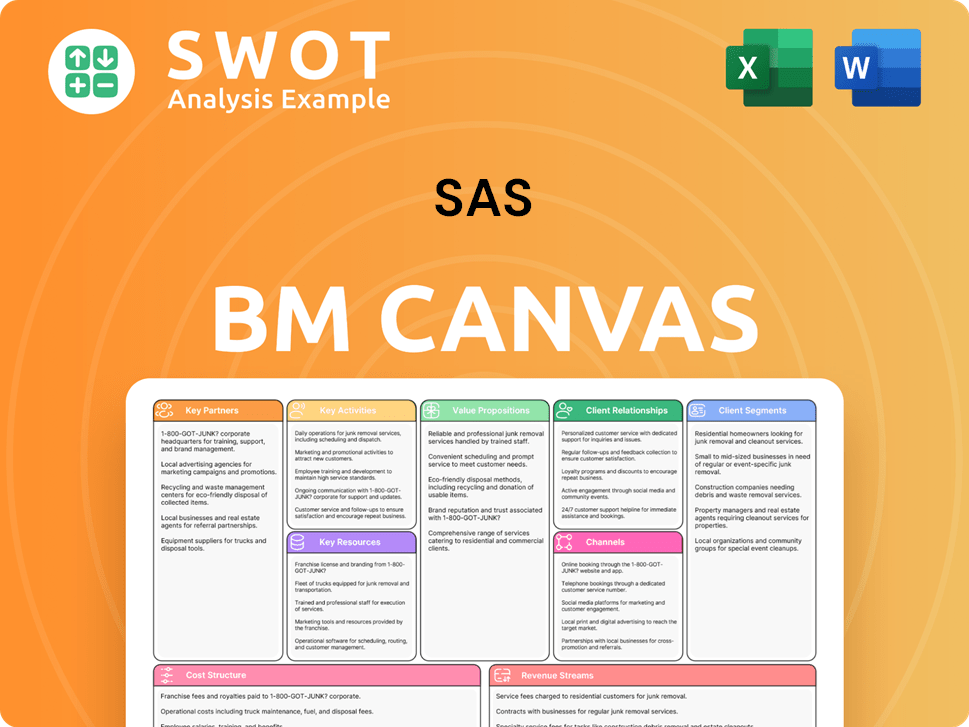
What Are SAS’s Most Notable Campaigns?
The sales and marketing strategy of SAS revolves around several key campaigns and strategic initiatives, driving growth and reinforcing its market leadership in data and AI. These campaigns are dynamic and adapt to market trends, customer needs, and technological advancements. The company leverages data-driven insights and innovative solutions to maintain a competitive edge and deliver value to its customers.
SAS's approach is multifaceted, encompassing product-specific promotions, industry-focused solutions, and thought leadership initiatives. The company's success is reflected in its financial performance and customer recognition. By focusing on these key areas, SAS aims to solidify its position as a trusted partner for businesses seeking to harness the power of data and AI.
The core of the SAS sales strategy involves continuous enhancement and promotion of its flagship product, SAS Viya. In 2024, this product saw a 24% increase in sales, with SAS Viya 4 sales alone growing by 56%. This emphasis on cloud-native data and AI platforms is a crucial part of the company's SAS company strategy, designed to accelerate the data and AI lifecycle for its customers.
The ongoing campaign focuses on promoting the cloud-native data and AI platform, highlighting its capabilities and benefits. The company actively promotes its ability to accelerate the data and AI lifecycle for customers, emphasizing productivity gains.
SAS focuses on industry-specific AI models and solutions, releasing 12 AI models as independent products in 2024, with more planned for 2025. This campaign targets specific industry needs. This is part of their SAS marketing strategy, providing tailored solutions.
The annual SAS Customer Recognition Awards showcase customers who have made exceptional contributions to AI and analytics knowledge. This initiative fosters a community of innovators and highlights real-world impact. The company also shares predictions for 2025, positioning itself as a thought leader.
SAS is committed to synthetic data generation for AI model training, addressing data access, cost, and privacy concerns. The upcoming release of SAS Data Maker in July 2025, developed from the acquired Hazy technology, underscores this commitment. This approach is part of the SAS sales strategy, offering advanced solutions.
SAS Porter's Five Forces Analysis
- Covers All 5 Competitive Forces in Detail
- Structured for Consultants, Students, and Founders
- 100% Editable in Microsoft Word & Excel
- Instant Digital Download – Use Immediately
- Compatible with Mac & PC – Fully Unlocked
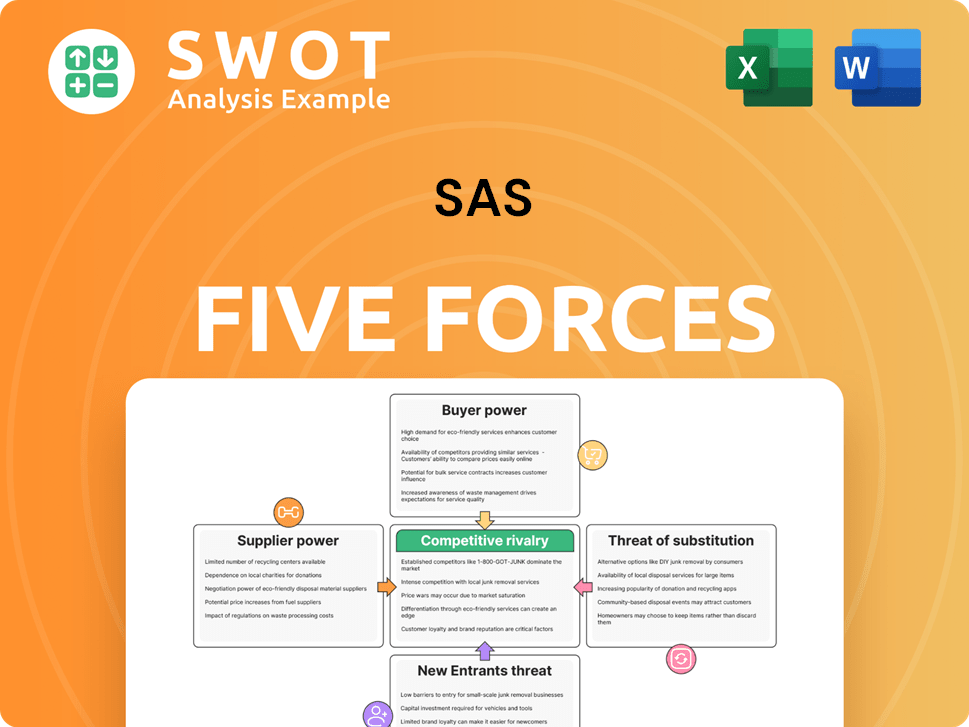
Related Blogs
- What are Mission Vision & Core Values of SAS Company?
- What is Competitive Landscape of SAS Company?
- What is Growth Strategy and Future Prospects of SAS Company?
- How Does SAS Company Work?
- What is Brief History of SAS Company?
- Who Owns SAS Company?
- What is Customer Demographics and Target Market of SAS Company?
Disclaimer
All information, articles, and product details provided on this website are for general informational and educational purposes only. We do not claim any ownership over, nor do we intend to infringe upon, any trademarks, copyrights, logos, brand names, or other intellectual property mentioned or depicted on this site. Such intellectual property remains the property of its respective owners, and any references here are made solely for identification or informational purposes, without implying any affiliation, endorsement, or partnership.
We make no representations or warranties, express or implied, regarding the accuracy, completeness, or suitability of any content or products presented. Nothing on this website should be construed as legal, tax, investment, financial, medical, or other professional advice. In addition, no part of this site—including articles or product references—constitutes a solicitation, recommendation, endorsement, advertisement, or offer to buy or sell any securities, franchises, or other financial instruments, particularly in jurisdictions where such activity would be unlawful.
All content is of a general nature and may not address the specific circumstances of any individual or entity. It is not a substitute for professional advice or services. Any actions you take based on the information provided here are strictly at your own risk. You accept full responsibility for any decisions or outcomes arising from your use of this website and agree to release us from any liability in connection with your use of, or reliance upon, the content or products found herein.